By the OER Project Team
Find direct links to ALL the updates described in the blog below with this handy 2023-24 OER Project Course Updates chart.
“Butter,” “Old Town Road,” “Bad Blood,” “Call Me Maybe,” “Hot in Herre,” “The Fox (What Does the Fox Say?).” Each year, there’s a song that comes out of nowhere to define your summer. What will be the soundtrack of your summer in 2023? Maybe it’ll be something totally new, or maybe a classic resurrected by a blast of nostalgia, like “Running Up That Hill (A Deal with God).” Then again, maybe you’re looking to split the difference and find a fresh update to some of your old favorites. If that’s the case, let me recommend “OER Project Updates, 2023”!
That’s right, it’s time for your favorite OER Project courses to get their annual glow up. Sit back, hit play, and touch grass. Here’s the tea: this playlist smacks.[1]
BHP & WHP Shared Updates | Big History Project | World History Project
Pueblo histories, presents, and futures
Histories of Indigenous American peoples are often excluded from dominant world-historical narratives. What can we learn when we include and contextualize Indigenous peoples’ histories in world history and Big History? We traveled to New Mexico with Jerad Koepp (Wukchumni) to find out. Jerad spoke with several Pueblo educators, leaders, and historians about the long history of Ancestral Puebloan people in the American Southwest and the importance of this history to Pueblo communities today. These five videos will be joining our BHP and WHP courses this year:
Written in Stone: Petroglyphs—What counts as a written source? Historians often give privilege to written evidence, and archaeologists insist that most Indigenous American societies didn’t have written language. Yet, at the Mesa Prieta Petroglyph Preserve in the Pueblo of Pojoaque, hundreds of thousands of rock carvings tell a different story.
Communities of Movement: Ancestral Puebloans—The Ancestral Pueblo built large, complex agricultural societies across the Colorado Plateau. Unlike the agricultural societies students read about in most world-history textbooks, movement—repeated migrations—were a central part of Pueblo agricultural life.
The World of Chaco—A thousand years ago, the Ancestral Pueblo made Chaco Canyon the center of their cultural world. For hundreds of miles in every direction, communities emulated the ideas and architecture of Chaco. Why did the Ancestral Puebloans choose to live here, and how did they learn to thrive in challenging environments?
Colonization and Resistance: Through a Pueblo Lens—In 1680, the Pueblos living under Spanish rule in Nuevo México revolted against their colonizers. It was the first successful revolt against European colonialism in what is now the United States. In this video, Porter Swentzell helps us situate this revolution in a global context.
Preserving the Past—Indigenous American communities, like the 19 Pueblos of New Mexico, are reclaiming their history. In this video, we hear from Pueblo leaders and educators about their history and why they’re fighting so hard to reclaim their stories, ancestral remains, and sacred lands.
And speaking of summer tunes, all music for these videos comes from “The River,” a collaboration between Robert Mirabal (Taos Pueblo) and the band ETHEL. If you’re taking auditions for your summer playlist, you can check out the full album here!
DBQ/Investigation writing samples
We’re expanding our arsenal of writing tools by providing DBQ and Investigation writing samples in BHP, WHP Origins, WHP 1200, and WHP 1750. These are student-written sample essays that give you and your students new material to help them develop and practice writing skills.
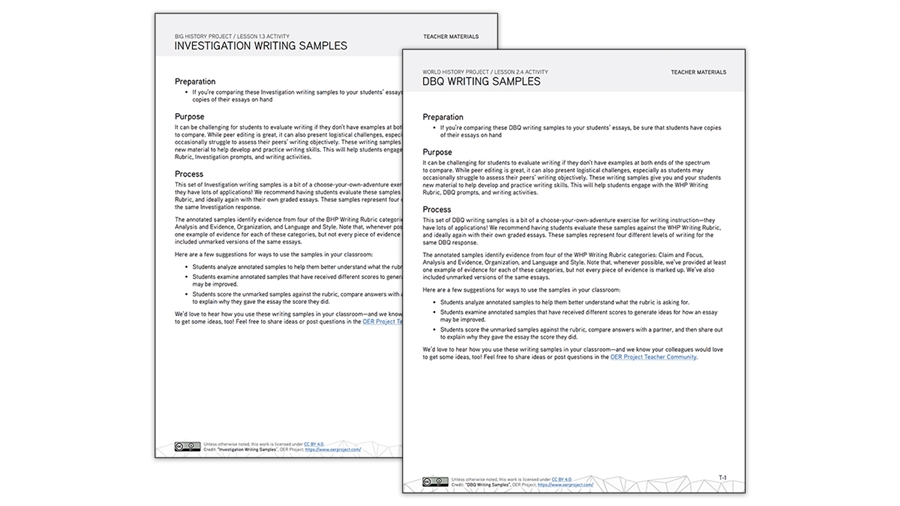
These samples are designed to help students evaluate writing by comparing responses at both ends of the spectrum. While peer editing is an important tool, anonymous samples can help overcome some of the logistical challenges of objectively assessing peer writing.
We’ve provided annotated samples that represent four different levels of writing for the same prompt and that identify evidence from four of the WHP/BHP Writing Rubric categories: Claim and Focus; Analysis and Evidence; Organization; and Language and Style. We’ve also included unmarked versions of the same essays. You'll find these samples included with every Investigation and DBQ (with the exception of Investigation 0 and DBQ 0, as we recommend using that as a baseline). Example from BHP | Example from WHP

These sample essays have lots of applications. In fact, they provide a bit of a choose-your-own-adventure exercise for writing instruction! You might choose to have students evaluate these essays against the WHP or BHP Writing Rubric and their own graded essays to help them better understand what the rubric is asking for or to generate ideas for how an essay could be improved. Students might also score the unmarked samples against the rubric, compare answers with a partner, and then share out to explain why they gave the essay the score they did.
These are just a couple of applications for these writing samples—we’d love to hear how you would use these essays in your classroom, and we know your colleagues would love to get some ideas, too! Feel free to share ideas or post questions in the OER Project Teacher Community.
Three Close Reads for Graphic Biographies
Graphic biographies may look like they will be a fast and easy read—but anyone who has used these materials in class knows that decoding a graphic biography requires a specific skill set. Comics require us to build new literacy skills, and we heard feedback that a tool that essentially mirrored our Three Close Reads for standard articles wasn’t doing the trick. Our new 3CR for Graphic Biographies tool invites students to become co-creators as they complete the three close reads: 1. Observe, 2. Understand, 3. Connect.

That’s not all! We also heard you when you asked for visual aids in modeling this type of reading. Our new Introductory Activity walks students step-by-step through a three close reads of one WHP graphic biography with a super guide: our own Dr. Trevor Getz! Though this activity uses a WHP graphic biography, it can still be used in BHP or Climate Project classrooms, as its lessons are broadly applicable. In the activity, our superhero introduces students to the basic elements of any comic, such as gutters, panels, and lettering. Next, they’ll see an example of how to uncover the main idea of a graphic biography and how to begin connecting that person’s story to the history narratives they’re learning. The activity concludes with a special new biography that challenges students to think about the differences between history and memory.
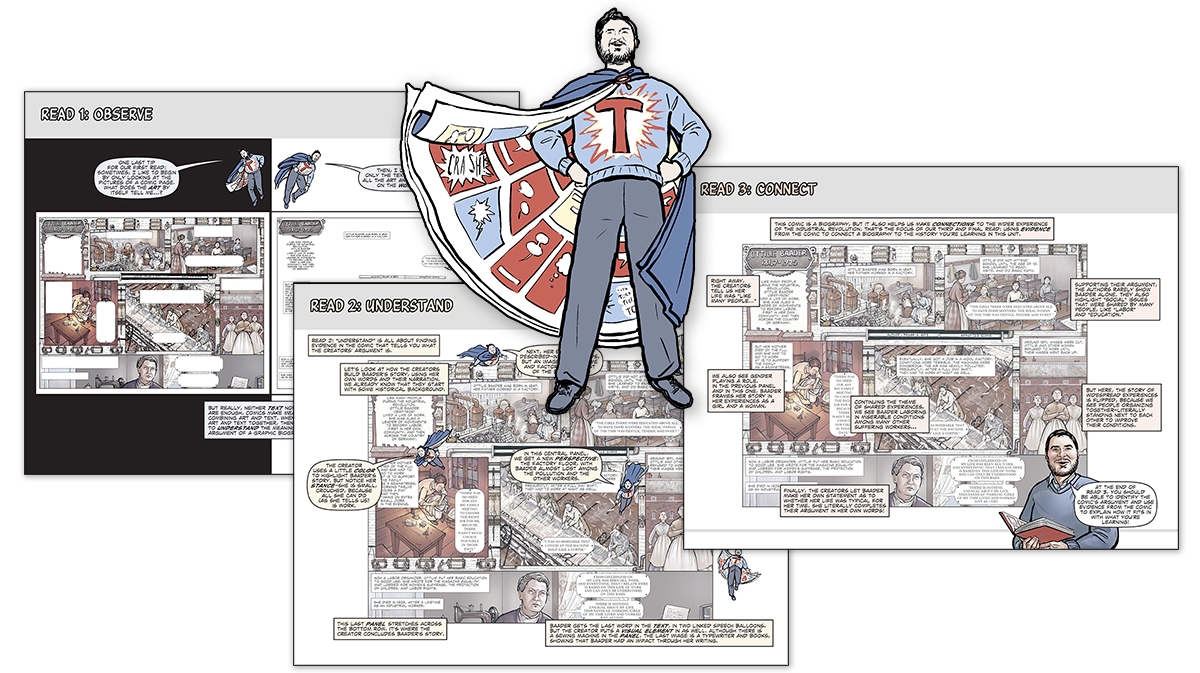
Comparing Complex Societies
Your feedback was essential in our decision to update BHP Lesson 7.1: The First Cities and States Appear. We’ve overhauled the article collection and its companion comparison activity. You’ll now find a set of eight new articles that align more closely with world-history standards. The new articles focus on the following complex agrarian societies:
- Mesopotamia
- Ancient Egypt
- China (Shang to Han Dynasties)
- Persia and Ancient Greece
- Ancient Rome
- Mauryan Empire
- Classic Mesoamerica
- Mali Empire
Each article has a similar layout with standardized subheadings to make it easier for students to complete the revised comparison activity, which includes a new tool that allows students to record the similarities and differences between complex agrarian societies for each question on the chart.
Writing updates
Just because something is old doesn’t mean it’s bad. But sometimes it does mean a little touch-up is in order. With that in mind, we made some tweaks to our Investigations. We’ve revised the directions and layout in our BHP Investigations to be a little more streamlined (here's an example from Unit 2). Note that we did not revise the Investigation libraries—because these are all Score prompts, any change to the source involves a “relearning” for the AI.
Here’s another change to the Investigations: We know that there’s often a time crunch at the end of the year, so we’ve moved the Unit 10 Investigation to Other Materials. If you want to have students do a summative writing assessment, we’d recommend using Investigation 9 for that, and then doing something a little more fun for the Unit 10 assessment (for example, Unit 10 PBL or Little Big History presentations).
Finally, we’re offering two new writing assignments in the form of DBQs. In Lesson 2.2, you’ll find a DBQ with the prompt, How has our understanding of the Universe changed over time? And in Lesson 4.3, a new DBQ asks students to write on the question, How has the Earth and our understanding of its structure and processes changed over time?[2]
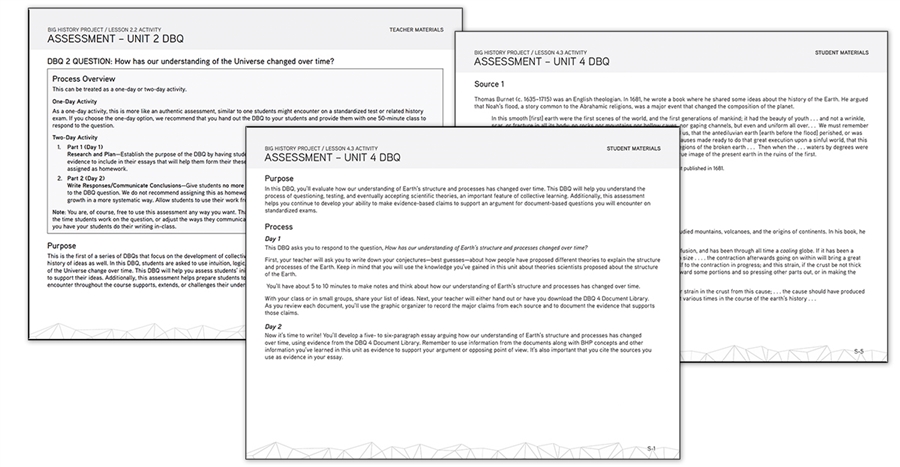
Practice progression update: Activity and tool revisions, new feedback forms
Our WHP course has been “live” for a few years now. Given the importance that skills play in all OER Project courses, we wanted to ensure that our WHP skills progressions and their related tools are truly fostering student learning. So, in the 2022/2023 school year, a group of WHP teachers implemented the progressions and provided us with detailed feedback about each activity and its related tools. In response to their feedback, we’ve revised each practice progression in the WHP course. Some revisions are minor and some progressions have had a major overhaul (we're looking at you, contextualization!). In addition, we've added feedback forms to each progression activity so you and your students can get a clear sense of their learning trajectories as related to each historical thinking practice. We're rolling these out throughout the summer and will provide updated practice progression placemats when they're all done!
Here’s a side-by-side explanation of the tools we’ve changed and our reasons for changing each of them.
Comparison: Similarities and differences are now side by side so all the information students need to compare appears together. Most progression activities only ask students to compare two things, and we've removed the frames to simplify even further.
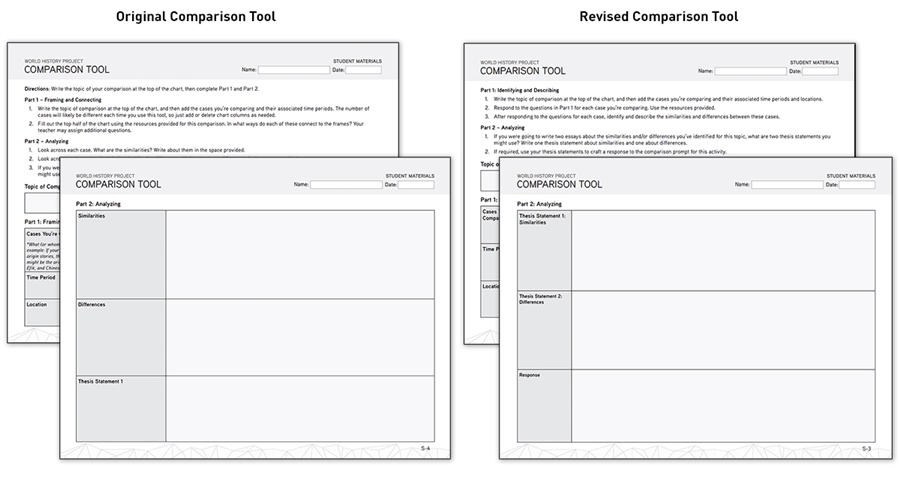
Sourcing: We’ve refined some of the questions and changed the orientation of the tool to be more intuitive and usable. We’ve also completely changed the intro activity—Chat GPT helped us create some scenarios for that!
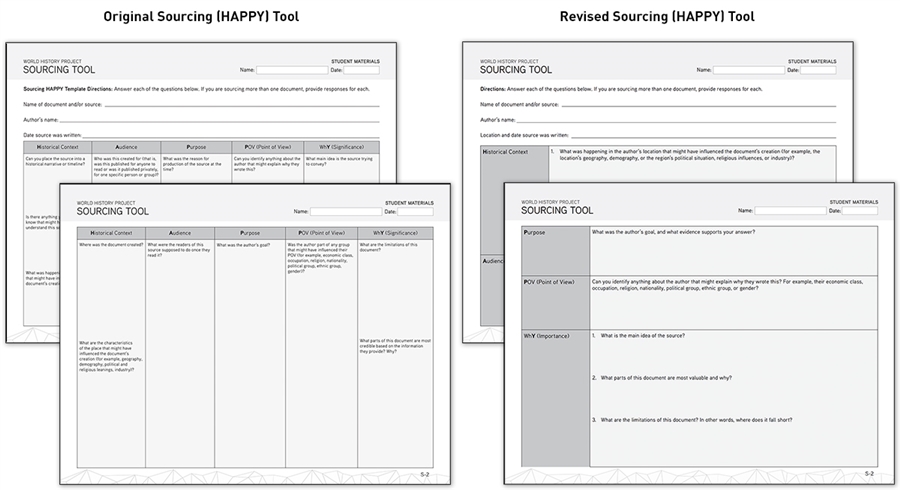
Causation: Don't worry—Alphonse is intact! And in BHP, we’ve even included an Autopsy of Alphonse. We’ve added effects to the tool and simplified the labeling process, as well.
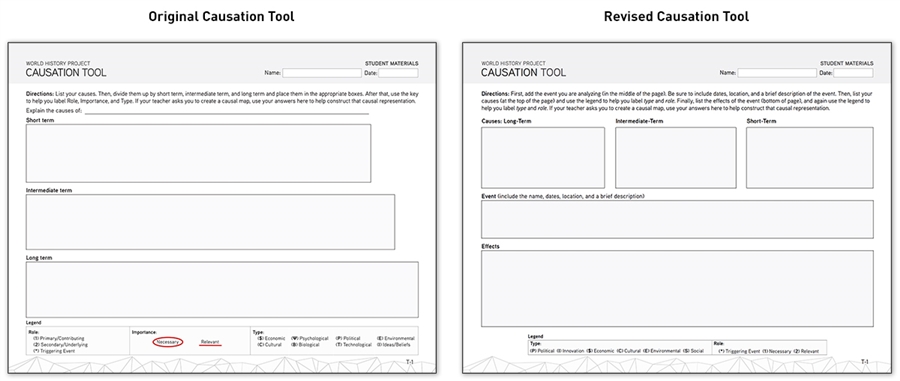
CCOT: While this one may look different, the process of graphing remains the same. We just reduced some of the up-front instructions.
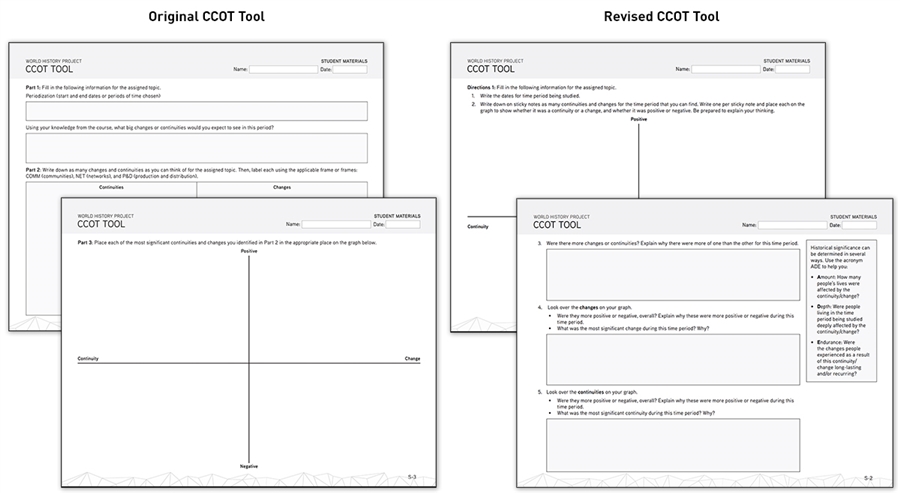
Contextualization: This is by far the biggest overhaul of all the tools. It just wasn't working. So we started from scratch. We have to thank Anne Koschmider and Julie Horowitz for really driving the creation of this new tool. It's now focused on broad and narrow context, and the progression kicks off with a fun example from a famous sporting event!
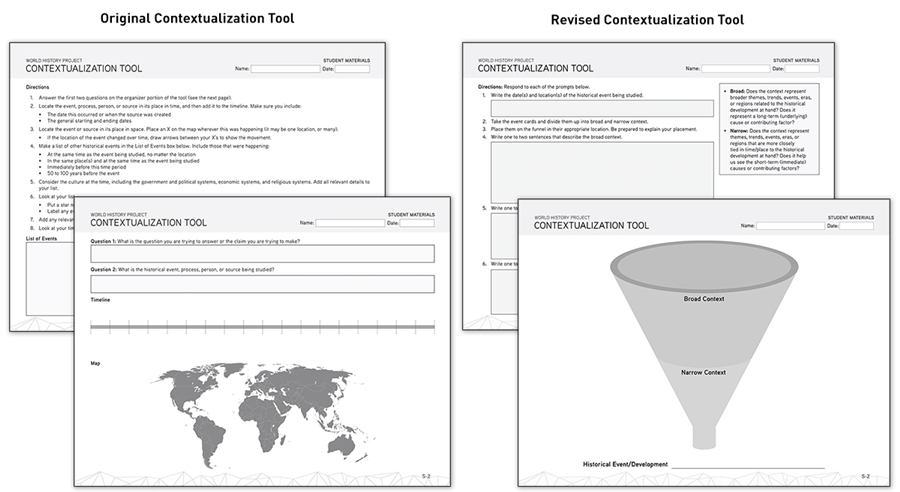
Claim testing: While there were some edits to the claim-testing progressions, those revisions weren’t very extensive, and they focused more on ensuring that the progression of historical thinking and release of scaffolding was appropriate. We don’t have a new claim-testing tool, but we do have a preview of the new feedback form for this progression.
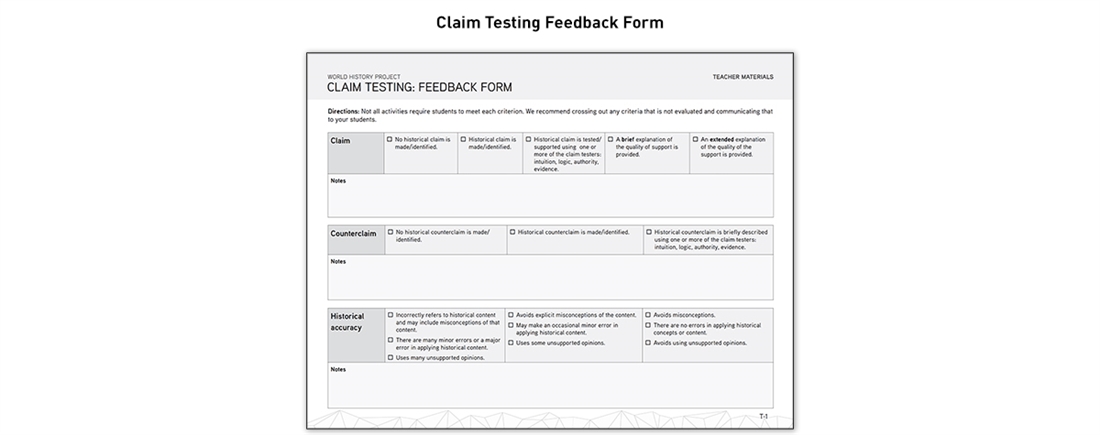
Build-a-frame
History is all about narratives. This idea is reinforced in all OER Project courses. Any historical narrative is always the product of a particular perspective. In our WHP courses, we use a device—frames—to tell three stories of the history of the world: the story of communities, the story of production and distribution, and the story of networks. We’re introducing a new activity, Build Your Own Frame, in which students will tell the history of the world from a frame of their choosing—using their own perspective. This will reinforce the concept that all historical narratives are presented through a particular lens. It will also give students an opportunity to think about the history of the world through a topic that is most interesting to them, helping to foster their historical inquiry skills.
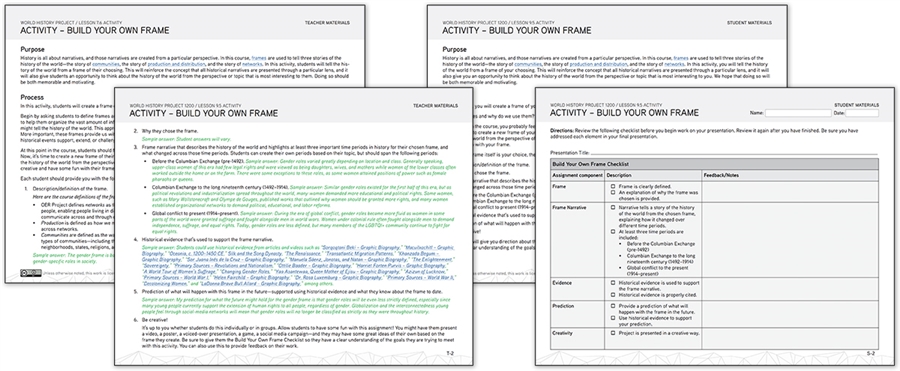
WHP en español
Just like BHP, WHP materials are now available in Spanish! Articles, activities, video captions, and video transcripts are available through the WHP Origins and WHP 1200 courses. Because of the shared materials between WHP courses, much of WHP 1750 is translated—the remaining 1750-only materials are in the process of being translated, and should be published to the site by late fall.
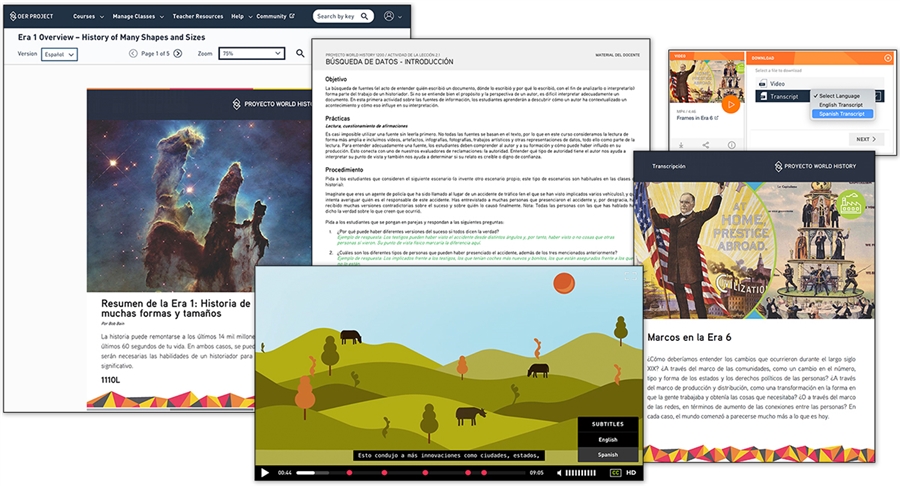
That’s it for our summer updates, although there are plenty more changes on the horizon! Remember, we rely on feedback from you to make OER Project courses better each year. We hope you have a restful and regenerative summer enjoying the playlist of your choice. But if you think of any ways we can make your life easier in fall 2023 and beyond, be sure to jump into the OER Project Teacher Community and let us know. We’re open all summer, and we miss you already!
[1] Disclaimer: The slang expressed in this publication does not reflect the views of OER Project. The author has been reassigned to a blog in Antarctica after this attempt to “connect with the youths.” We are sorry.
[2] Note: These new DBQs are not currently available in Score.
Cover image: Composite of a music audio tape, © fabrikasimf / freepik.com; a camel (camelus dromedaries) looks at the camera with a strange and funny expression at the Al Ain Camel Market, © Edwin Remsberg / Image Bank / Getty Images.
 For full access to all OER Project resources AND our amazing teacher community,
For full access to all OER Project resources AND our amazing teacher community, 




Top Comments